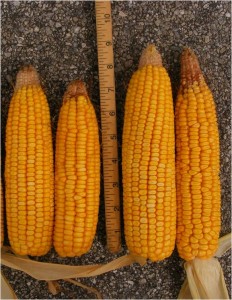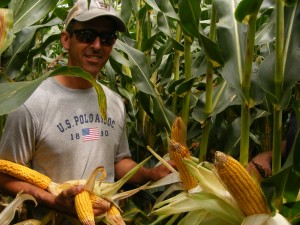
During my past five years with the Midwest Cover Crops Council, I have heard cover crop experts say that “the farmer who has access to manure is the perfect candidate to use cover crops.”
I witnessed this truth up-close and personal this fall when visiting the Leman farm in NW Indiana. The Leman family has a dairy farm and several acres of corn silage (the acres are usually planted to corn silage each year). For years they fall applied manure to their fields with little nitrogen value being realized in the spring.
The soil is rather sandy and the manure had little to keep it in the soil root zone (but it had not been running off). These past three years the Leman’s have been using cover crops in their corn silage fields with impressive results. This year Scott Leman told me that he will “never stop” using cover crops because of the value they are finding.
Each year they leave sections of 30-36 rows in the silage fields that they leave for grain harvest. In these areas they did not plant cover crops (until this year).
This fall Mark Perry, from CISCO Seeds, and I went to the farm with Randy Davis (Country Acres in Francesville, IN) and Curt Leman to see what difference we might find between where they had a cover crop planted (N-Vest® Soil Builder Annual Ryegrass Blend) and where there was no cover crop planted. The results were astounding…but not totally unexpected!
Where there was a cover crop there was much better plant health and bigger ears on the corn. Curt was convinced that there would be a 20 bushel/acre or more advantage where there was a cover crop.
I did not take plant samples to send off to the lab to test forage quality on the silage, but I wish I had. All I know is that there was more grain on a green stalk where they had the cover crop. Where there was no cover crop the stalks were pretty dry nearly up to the ear and ~2” less grain per ear of corn.
The Lemans also cut back 50#/acre on their nitrogen application on their fields. So, they saved $20+/acre on N cost and added 20 bu/acre on yield (at $4.50/acre) = PROFIT. Save $20/ac — add $90/acre on yield = $110/acre. The seed cost was approximately $30/acre with $10 cost of application.
$110 – $40 = $60/acre added profit from using a cover crop.
Add in the benefits of cleaner water, less wind erosion, improved soil biology, increased soil organic matter, and less potential for manure run-off, I’d say that the Lehman’s are right in using cover crops each year.
The photos below show some of the value. Click on them to see a larger view.



